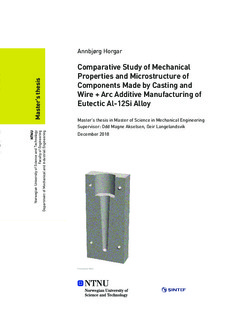| dc.contributor.advisor | Akselsen, Odd Magne | |
| dc.contributor.advisor | Langelandsvik, Geir | |
| dc.contributor.author | Horgar, Annbjørg | |
| dc.date.accessioned | 2019-10-15T14:01:12Z | |
| dc.date.available | 2019-10-15T14:01:12Z | |
| dc.date.issued | 2019 | |
| dc.identifier.uri | http://hdl.handle.net/11250/2622349 | |
| dc.description.abstract | Masteroppgaven vurderer sammenhengen mellom additiv tilvirkning ved lysbuesveising med trådmater (eng. Wire and Arc Additive Manufacturing, fork. WAAM) og støping av aluminium legert med silisiuminnhold (Si) på 12% (Al-12Si). WAAM er en teknikk for å sveise lagvis tredimensjonale produkter designet i dataassistert konstruksjon (eng. computer-aided design, fork. CAD), og er lønnsom for småserieproduksjon. Det er per desember 2018 lite litteratur om WAAM-teknologi, særlig kjølehastigheten. Støpeteknologien for aluminium kan fylle tomrommet og akselerere utviklingen av WAAM.
Denne studien sammenligner arbeidsstykker i Al-12Si-legering tilvirket ved WAAM og støping, med hensyn til deres mekaniske og mikrostrukturelle egenskaper. WAAM-arbeidsstykket er av legeringen Aluminium Association (AA) 4047 og ble skåret inn i mindre prøver. Støpestykkene er av legeringen Al-12Si med tilsatt strontium og ble støpt i en permanent stålform og i tre sandformer. Permanentformen kan gjenbrukes for flere støpninger, mens sandformene kan brukes kun én gang. Støpeformen er sylformet for å tilsvare en typisk sveisestreng og for å oppnå et spektrum av kjølehastigheter.
To bruddmekanismer er observert i bruddflaten på en permanentstøpt strekkprøve etter gjennomført strekktest. Den ene er sprøe (Si) partikler og den andre gass- og krympeporer. Al-12Si-legeringen er duktil og brekker når spenningskonsentrasjonen finner sted ved de skarpe partiklene eller porene, og vokser til intergranulære brudd. De observerte dendrittsporene indikerer inneslutninger mellom dendrittarmene.
Sekundær dendrittarmsavstand (SDAS) måles for prøvene og brukes deretter i beregning av kjølehastighetene. Resultatene er avrundet til 6 μm i avstanden og 620 Ks-1 i hastigheten for WAAM-prøvene, 11 μm og 100 Ks-1 for permanentstøpningene og 21 μm og 15 Ks-1 for sandstøpningene.
SDAS for WAAM er større i delvis smeltet-sonen enn i smeltesonen. Dendrittene i varmepåvirket-sonen er små og sammenklemt. En mulig sammenheng i SDAS-målingene er funnet for smeltesonen i WAAM-prøven og for midtdelen av permanentstøpningen. Sammenligningen av de mekaniske egenskapene for Al-12Si-prøvene kan tolkes dithen at jo større kjølehastighet, desto høyere styrke, større forlengelse og høyere hardhet. En permanentform med enda mindre diameter kan oppnå SDAS og kjølehastigheter tilsvarende de for WAAM-prøven.
Ytterlig arbeid bør utføres for å analysere fasene rundt de utfelte (Si)-partiklene og dendrittene, og for å kartlegge komponentelementegenskapene til WAAM-prøven og støpningene. | |
| dc.description.abstract | The Master’s thesis study evaluates the relationship between the wire and arc additive manufacturing (WAAM) and the casting process for the aluminum-silicon alloys with silicon (Si) content of 12% (Al-12Si). The WAAM deposits layer-by-layer three-dimensional products defined by computer aided design and is profitable for small-series production. By December 2018, there is little literature on WAAM technology, especially regarding to the cooling rate. The aluminum casting technology can fill the gap and help the development of WAAM.
In this study, Al-12Si samples produced by WAAM and casting are compared by their mechanical and microstructural properties. The WAAM sample is of the Aluminum Association (AA) 4047 and was sliced into specimens. For the casting samples, the melted alloy Al-12Si was added strontium and casted into a permanent steel mold and into three sand molds. The permanent steel mold could be reused for serial casting while the sand molds were for one-time casting only. The molds are awl-shaped to correspond to a common weld bead and to obtain a spectrum of cooling rates.
Two fracture mechanisms are observed in the fracture surface of a permanent mold cast tensile specimen after completed the tensile test. The first are the brittle (Si) particles and the second the gas and shrinkage pores. Al-12Si is ductile and fractures when stress concentration takes place in the sharp-edged (Si) particles or pores and grows to intergranular fracture. The observed dendrite traces indicate inclusions between the dendrite lobes.
The secondary dendrite arm spacing (SDAS) are measured for the specimens and then used in calculating the cooling rates. The results are rounded to 6 µm in the space and 620 Ks-1 in the rate for the WAAM specimens, 11 µm and 100 Ks-1 for the permanent mold castings and 21 µm and 15 Ks-1 for the sand mold castings.
For the WAAM, the SDAS are larger in the partially melted zone than in the fusion zone. The dendrites in the heat-affected zone are small and entangled. A potential relationship with respect to the SDAS is found between the fusion zone in the WAAM sample and the middle of the permanent mold castings. The comparison of the mechanical properties can be interpreted as the increased cooling rate in the Al-12Si samples, then higher strength, larger elongation and higher hardness. A permanent mold with even smaller awl diameter might allow achieving SDAS and cooling rates closer to the WAAM sample.
Further study should be carried out to analyze the phases around the precipitated (Si) particles and the dendrites and to map the component elements properties of the WAAM sample and the casting samples. | |
| dc.language | eng | |
| dc.publisher | NTNU | |
| dc.title | Comparative Study of Mechanical Properties and Microstructure of Components Made by Casting and Wire + Arc Additive Manufacturing of Eutectic Al-12Si Alloy | |
| dc.type | Master thesis | |
